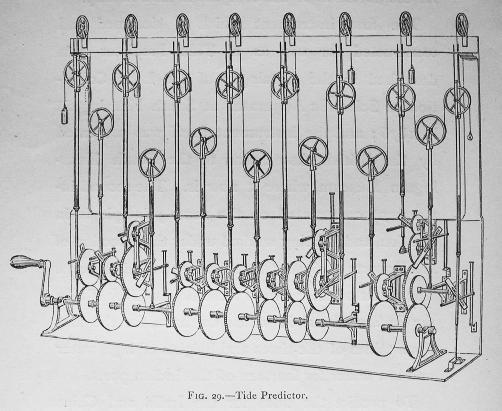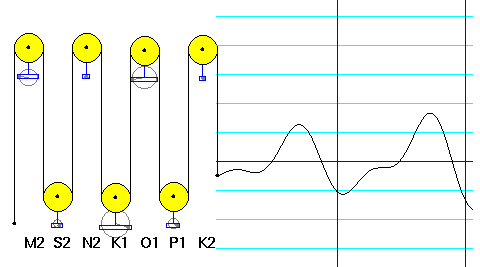A wire is fixed at the right and passes
alternately over and under 15 movable pulleys,
after which it suspends a weight
(in this image; in practice, an ink bottle with a pen). Each of the
movable pulleys is driven in a vertical simple harmonic motion, as
follows.
- Turning the crank it drives eleven gear
assemblies. The gear ratios are chosen so that the speeds of the
output gears in each assembly are uniformly proportional to the
speeds of the tidal constituents being summed. (Two of the assemblies,
#3 and #9 counting from the left, have two output gears, corresponding
to pairs of rationally related constituents; one of them, #11,
has three).
- Each output gear drives
one of the movable pulleys by an linkage which converts the
rotation of the gear into vertical harmonic motion. The linkage
attachment to the gear is by an eccentric pin mounted at an adjustable radius.
In this way the amplitude of the vertical motion can be set to match
the coefficient of the corresponding constituent at the port in
question. Likewise the initial angle of each pin can be set
so that all the constituents are in the correct phase for the
moment the simulation is to start.
- One last wrinkle: the pulleys
in the lower row must be set 180 degrees out of phase with those
in the upper, because when they go up, the pen goes down. The motion of
the pen is then exactly twice the sum of the motions of the pulleys.
The crank also moves a strip of paper horizontally in front of the
pen (this is not shown) to record the predicted tidal curve. Image
from Kelvin, Mathematical and Physical Papers, Vol. VI, opposite
page 304. The planning of the gearing, which gives excellent
rational approximations to the astronnomical ratios, was carried
out by the mathematician Edward Roberts, who also supervised the
construction.
|


